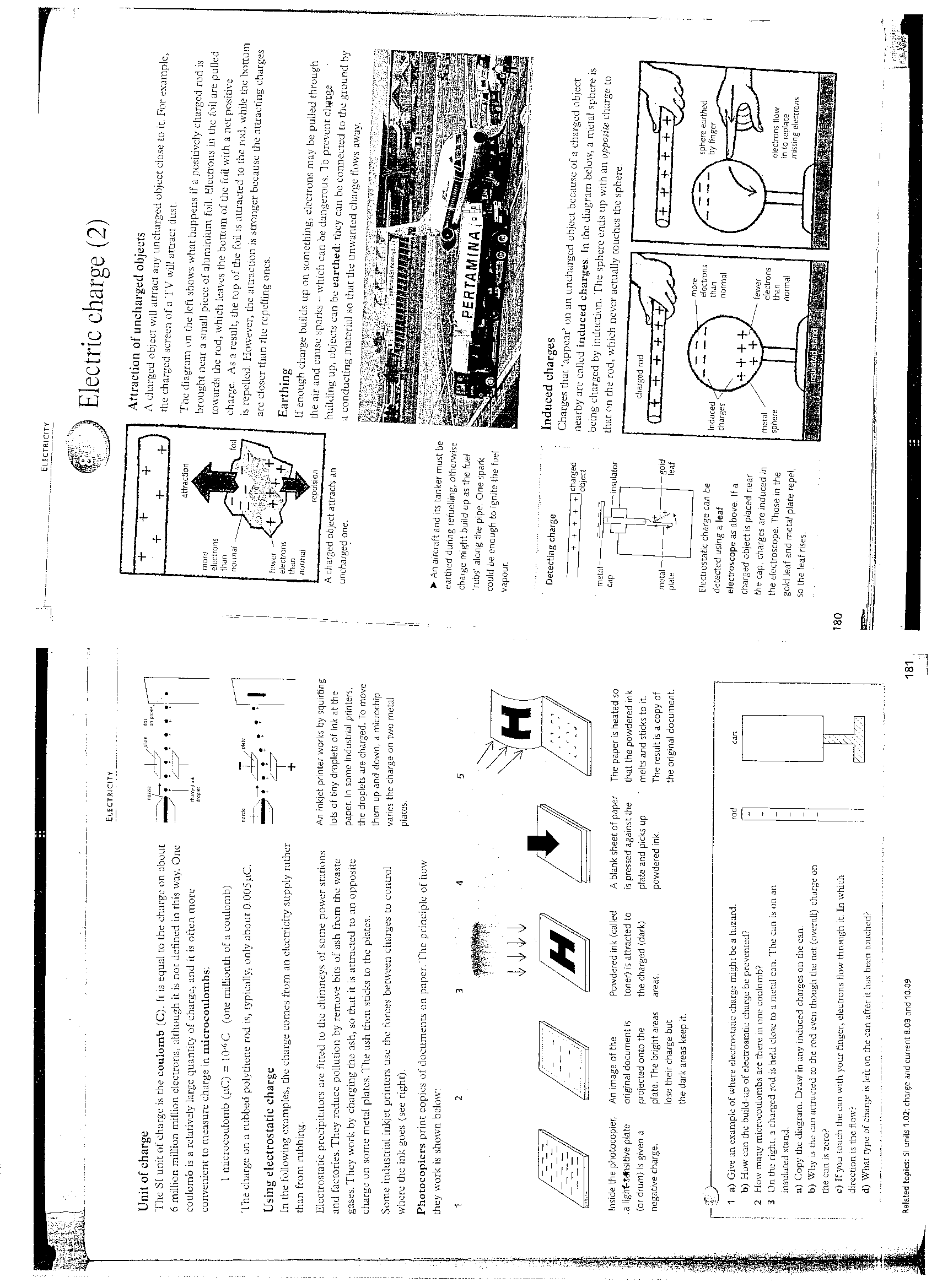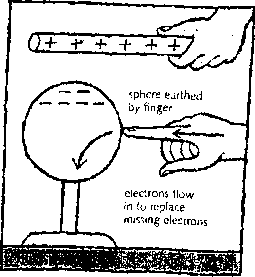sc ele charge2 bmp

Electri CtTV
Unit o {'charge
The SI unit of charge is the eoulomb (C). !t is equal to the charge on about 6 rmlhon milliun million electrons, ■although it ii not detined. in r.his way. One eoulomb is a relarivdy large quantity of charge, and it is ofert morę convcnient to measure charge in microcoulombs:

1 mierocouiomb (uC) = 10-f,C (one millionth of a eoulomb)
The charge on a rubbed polythene rod is, cypically, only about O.OOSuC.

In the following examples, the charge eomes from an electricity supply rather ^ |
dian from rubbtng.
Electrostatic precipitators are fitted to tlić ehimneys of some power stations An ink)et printer works by squirting
und faetories. They rcduce pollution by remove bies of ash from che waste gases. They work by chaeging the ash, so that it is attracted to an opposite
charge on some metal platcs.The ash then sticks to the plat.es.
lots of tiny droplets of ink at the paper. In some industrial printers,
the droplets are charged. To move
Some industrial inkjet printers use the fontes between charges to control wherc tire ink goes (see right).
them up and down, a microrhip
wtries the charge on two metal plates.
2
3
4
5

Inside the pnotocopier, An image of the
Powdered ink (called A blank sheet of paper The paper is heated so
Photocopiers print copies of documents on paper. The prineiple of how they vvork is shown bdow:
1
.a ligh*-t#tsitive piąte original document is toner) is attracted to is pressed against the that the powdered ink
for drutn) is given a projected onto the the charged (dark)
negative charge. piąte. The bright areas areas.
piąte and picks up ' melts and sticks to it. powdered ink. The result is a copy of
lose their charge but the dark areas keep it
the original document.

1 a) Give an csample of where electrostatic charge nught be a hazard.
| b) How can che build-ap of electrostatic charge be prevented? i 2 How many microcoulombs are there in one eoulomb?
; 3 On the righi, a charged rod is heid close ro a metal can. T he can is on an
: insulared stand.
; a) Copy tlić diagram. Draw in uny induced charges on che can.
■ b) Why is the can attracted to the rod even though die net (worali) charge on

; tire can is zero?
| c) If you touch die can with yoer finger, eleecrons How through it. In which
: direedon is the How?
d) Whal type of charge is iefr on the can. after ir hus been touched?
181
Mated topies: SI units 1.02; charge and current8.03 and 10.09
j!.....
EL£CTRICITV


ii
I
!
i

A diarged object attracts ari uncharged one.
Attraction of uncharged objeuts
A chargcd object will aLtract any uncharged object close to it. For example, rhe diarged screen of a TV wili artract dust.
The diagram on the lefi shows what happens if a posiiivdy chargcd rod is brought ncar a smali piece of aluminium foil. Hlcetrons In the foil are pulled towards Lbe rod, which leaves the bortom of the foil with a net positive charge. As a resulc, the top of the foil is auracted to the rod, whiie the bortom is repelled. Ho\vever, the attraction is stronger beeause the attracting charges arc closor tlian rhe repclling ones.
Earthing
IX enough charge builds up on something, eleerrons may be pulled rhrough ihe air and causc sparks - whieh can be dangerous. To prevent chjtige buiMing up, objects can be earthed: they can bo connected to tlie ground by a conducting materiał so that the unwanted charge flows away.
► An aireraft and its tanker must be earthed during refuelling, othorwise charge might build up as the fuel 'rubs' along the pipę. One spark could be enough to ignite the fuel vapour.

Detecting charge
+ + + +
ri charged -*object

Induced charges
Charges rhaL 'appear’ on an uncharged object bucause of a chargcd object nearby arc callcd induced charges. In the diagram belo w, a merai .sphere is being chargcd by induction. The sphere ends up wirh an opposite charge to that on die rod, which ncvcr actually rouches the sphere,
Efectrostatic charge can be detected using a leaf electroscope as above. If a charged object is placed near the cap, charges are induced in the electroscope. Those irt the gold leaf and metal piąte repd, so the leaf rises.

diarged rad
tEŁt-ł +

(
180

Wyszukiwarka
Podobne podstrony:
Activity 1-2b3-D Blocks and the Corner Piece The volume of a box is equal to length, times width, ti
sc ele charge1 bmp fElectric charge (1) rhis person has been charged up. Her hairs a!! carry tbe sam
zegar13 bmp Name_ Datę_ Draw the hands on each clock to show the correct time. copyright© 2001 Comp
zegar22 bmp Name_ Datę_ Draw the hands on each clock to show the correct time. 10:10
zegar23 bmp Name_ Datę_ Draw the hands on each clock to show the correct time. 11:05
zegar24 bmp Name_ Datę_ Draw the hands on each clock to show the correct time. 12:50
zegar25 bmp Name_ Datę_ Draw the hands on each clock to show the correct time. 1:50
zegar28 bmp Name_ Datę_ Draw the hands on each clock to show the correct time. 9:05
godziny1 bmp Name_ Datę_ Draw the hands on each clock to show the hour.9:30
więcej podobnych podstron